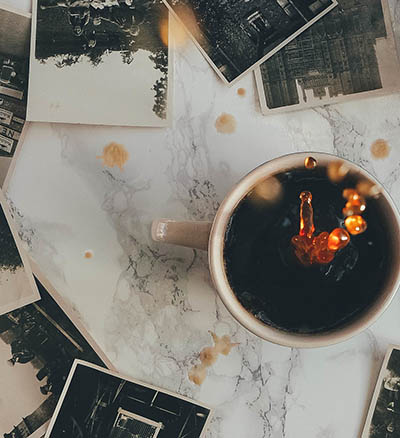
Photographs, as much as we wish they would, were unfortunately not made to last forever.
Made of sensitive materials which are fragile and vulnerable, many have lasted far longer than was intended. With a few simple steps you can ensure that they last for many more years.
In this blog we look at what causes photographs to fall apart, with tips to care for them.
What causes photographs to fall apart?
There are ten causes, called the 'ten agents of deterioration'. The ten agents of deterioration are:
- Humidity
- Temperature
- Light
- Chemical
- Pests
- Neglect
- Physical force
- Fire
- Water
- Theft and vandalism (one you'll have to investigate yourself!)
Let's look at each agent of deterioration in turn and how we can address them:
1. Humidity
Humidity is the measure of the amount of moisture in the air, more accurately known as Relative Humidity [RH]. RH is the most important factor in what causes your photographs to fall apart. All of the processes which cause your photographs to age and and become unusable require moisture. A high RH (damp) speeds up the rate at which your photographs fall apart.
High RH can also:
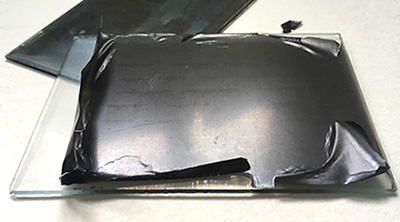
A low RH (dry) can:
- Make photographs brittle
- Cause photographs to crack
If the amount of moisture in the air is constantly changing this is worse than if the amount of moisture is static. A constantly changing level of moisture in the air means that your photographs are constantly expanding and contracting putting them under a lot of stress.
Right: a flaking glass plate negative with significant lifting and curling due to humidity
You should keep the RH as low as possible (no lower than 30%RH) and as stable as possible – you can easily monitor this with a hygrometer like this one which will also provide a temperature reading
So, think about where you keep your photographs:
- Cellars are notoriously damp, so avoid those
- Likewise, an attic may be too dry
- Keep your photographs off the floor
- Don't hang them on cold north facing walls
- Store and display your photographs away from away from sources of moisture such as kitchens and bathrooms.
If you store your photographs in boxes, that's great, because the boxes will protect your photographs from the changing levels of humidity.
You may like to take further steps to control the humidity by using a humidity control cassettes. These are pre-conditioned to maintain a stable RH level.
2. Temperature
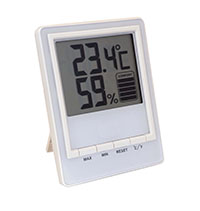
Temperature controls how fast your photographs fall apart. The warmer it is, the faster your photographs will deteriorate.
As with RH, a static temperature is better than one which is constantly changing.
Keep your photographs in as low a temperature as possible that changes as little as possible.
You may not realise it, but a higher temperature speeds up the life-cycle of some insect pests; so, the warmer it is, the more insect pests you could have feasting on your photographic collection! (see point 5 for more information)
3. Light
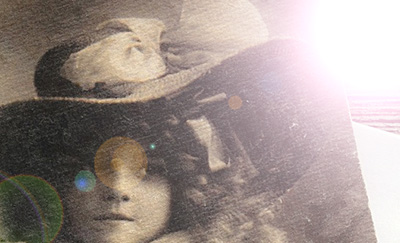
All light will damage your photographs, but light with high concentrations of blue and Ultra Violet [UV] such as daylight and unfiltered fluorescent light is the most damaging.
Light causes fading. Light also causes the papers and boards that your photograph may be printed on or mounted in to discolour and become brittle.
Light damage is cumulative and cannot be reversed. A simple solution is to store your photographs in the dark, such as in a box or in a cupboard. If you have them on display, try to place them away from windows. You may want to fit UV filtering glass to the frame. You could also fit UV filtering film to the windows and any fluorescent lights. Alternatively, you may find it a better solution to display copies, keeping your precious originals in the dark.
4. Chemical
This means pollutants. Pollutants can be dust, skin, hair, fibres, soot and pollen which cause dirt, abrasion and can attract insect pests and moulds. Pollutants can also be gases from aerosols, paints, glues and air fresheners. These gases can cause fading and discolouration of your photographs and make the paper and card supports brittle.
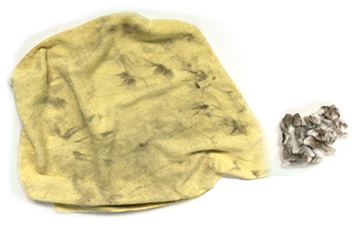
Controlling pollutants is relatively easy. Make sure that you keep the areas where you look at and store your photographs clean and tidy. A weekly vacuum using a cleaner fitted with High Efficiency Particulate Air [HEPA] filters is a good idea. Dusting with a micro fibre cloth or Dust Bunny in the areas where your photographs are stored is also a good idea. You can view all cleaning materials here.
Try not to use any aerosols, paints, air fresheners and other items which put gases into the air in areas where you use and store your photographs. If you are painting, or having a new carpet laid, move your photographs to an unaffected area and allow the gases to dissipate before moving your photographs back, if possible.
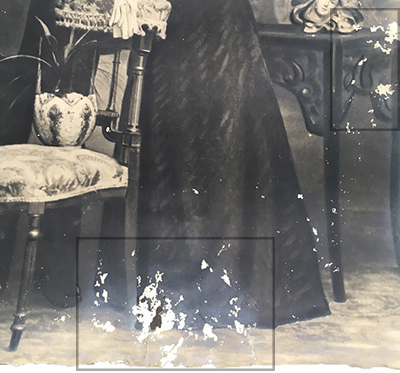
5. Pests
Your photographs provide food for moulds and insects like silverfish or carpet beetles. They are at risk from moulds, insects, rodents and birds and their droppings. These pests can cause complete loss of the image, discolouration and staining and can decimate a collection.
The best advice for reducing the risk from pests is regular cleaning. Make sure that you check along window sills and around doors because this is where insects will get access. Most insect infestations are caused by bird nests which as they provide a nice home for pests, so if you have nests check these areas for insects.
You can monitor for pest infestations using an insect monitor which could highlight an issue you may not be aware of and allow you to stop it faster.
Right: A photograph damaged by mould
6. Neglect
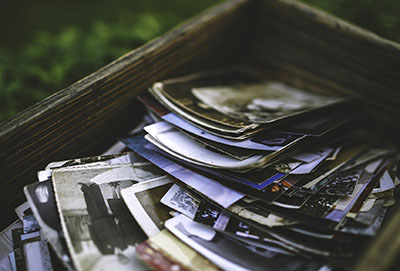
Are your photographs all muddled together in a shoebox? Are they stored in a plastic bag in the wardrobe? This is what is meant by neglect.
Your photographs may be in old cardboard boxes or brown paper envelopes. These boxes and envelopes are likely made from materials which were never meant for the long-term storage of your precious collection. These boxes and papers will become acidic over time damaging your photographs accelerating the deterioration and causing them to fall apart faster. These boxes and envelopes will also fall apart over time, the resulting debris will drop all over your photographs adding to dirt and abrasion. In addition, these boxes and envelopes, which may have been nice and strong when they were first used, may lose their strength as they age. The last thing you would want when you pick up a heavy box or envelope is for the bottom to collapse, or side detach, leading to inevitable damage to your photographs.
A range of photograph boxes, envelopes, and other enclosures suitable for long-term storage are available to view and buy here
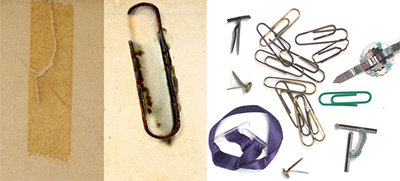
It's also important to think about what may be enclosed with your photographs, such as papers clips, rubber bands, sticky tape and plastic envelopes. These can seem innocuous, but can cause irreversible damage to photos including; rust stains, yellowing and discolouration. We’ve got a blog on the subject of fasteners in conservation here.
What to store your photographs in is such a big topic that we will look at it in greater detail a future blog. You may wish to look at the range of photo storage options for long term use here.
7. Physical force
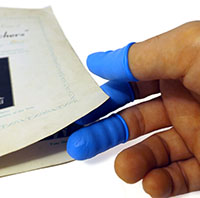 This is all about how you handle your photographs, handling causes considerable wear and tear to your photographs. Photographs are easily damaged when handled. Your photographs can be broken, chipped and cracked if they are on glass, for example, a glass plate negative . Poor handling can cause tears, losses (where whole sections of the image are detached) and scratches to your photographs.
This is all about how you handle your photographs, handling causes considerable wear and tear to your photographs. Photographs are easily damaged when handled. Your photographs can be broken, chipped and cracked if they are on glass, for example, a glass plate negative . Poor handling can cause tears, losses (where whole sections of the image are detached) and scratches to your photographs.
Photographs are easily damaged by the oils in your skin and it is for this reason that you should always wear nitrile gloves or finger cots when handling your precious photographs. You might be asking why can't I wear cotton or latex gloves? We'll cover this in more detail in our upcoming blog which is all about handling.
8. Fire and 9. Water
It's best to put these together as risk to your collection, conservators would call this ‘Disaster Planning and Preparedness’.
The threat that fire poses to your photographs is obvious. There have been numerous examples recently of the damage that fire causes to historic objects and buildings. Clandon Park and Notre Dame are two high profile fires that devastated not only the building, but the collections housed within.
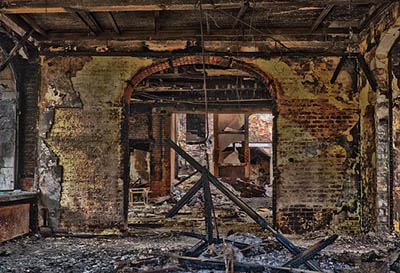
You should take all reasonable steps to prevent fire, if not only for your own personal safety, but also for irreplaceable collections.
Your photographs are at risk from water damage from leaks, floods, or accidental spillages such as knocking over a cup of tea. You should always try to work in a clean and uncluttered area, and if you have a drink, move it away from where it can cause damage.
Check your drains and guttering for blockages, and after a period of cold weather check that you have no leaking pipes. Prevention is better than cure, if possible, you should store your photographs away from sources of water and at least 15cms off the floor. Storing in a suitable box will also offer protection from accidental splashes.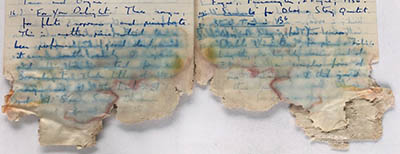
Water alarms are available to warn you of leaks and can be placed in storage areas for peace of mind.
I do have a good news story about a flood and the owner's precious family photographs. The flood was caused by a river overflowing. All of the owner's irreplaceable family photographs were stored in the bottom drawer of wooden chest of drawers. The flood went over the level of the drawer and when the flood receded the drawer was stuck fast. The owner despaired thinking that she had lost everything. However, when she finally managed to get the drawer open the photographs were completely dry and undamaged. The wood had swollen and sealed the drawer, keeping the photographs safe! I have heard of this happening in Record Offices. Archive boxes made of card have sat in water after a disaster, but have protected the contents keeping them completely dry and pristine. A very good argument for storing your photographs correctly.
Getting a reaction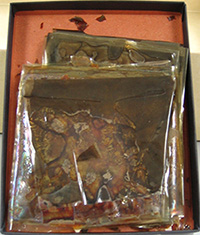
One final point on what causes photographs to fall apart, and that's the photographs themselves. Photographs involve complex chemistry which doesn't stop reacting. For example, albumen prints contain sulphur which causes them to yellow. Cellulose nitrate negatives (as shown on the picture) produce nitric acid which causes the plastic to become brittle, bleaches out the image, and eventually causes the complete loss of the negative.
If you're unsure what type of photograph you have, please read our articles on identifying photographic processes here.
Caring for your photographs is easy to do. It only needs a little thought and planning. Caring for your photographs will ensure that you can enjoy your them for many years to come.
This post was written by Lorraine Finch ACR. Lorraine is an accredited conservator of paper and photographs.
You can contact Lorraine Finch in the following ways: E: paperconservation@btinternet.com | W: www.lfcp.co.uk | T: @conserve_lfcp | Facebook: LFCandP